*This post may contain affiliate links. Read more »
Kala Chana is a protein-packed sattvic vegan curry made from black chickpeas that celebrates the flavors of Navratri! Sukha Kala Chana holds a special place in the hearts and palates of millions during Navratri, a nine-night (nava means nine, and ratri means nights in sanskrit) Hindu festival dedicated to the worship of the divine feminine. As devotees observe fasting rituals, this protein-packed curry emerges as a nourishing source of energy and sustenance.


Enter your email & I'll send it to your inbox. Plus, get great new recipes from me every week!
By submitting this form, you consent to receive emails from Cinnamon Snail.
With their dark hue and robust flavor, kala chana (black chickpeas) have been an integral part of Indian cuisine for centuries. They offer a nutritious foundation for this wonderful curry, which I love to serve as bhoga for our deities at home.
If you are new to sattvic cooking, you may wonder “How the heck is this going to be flavorful without onions and garlic?!?” Fragrant cumin, coriander, vibrant Kashmiri red chili powder, and a touch of tangy amchoor (dried mango powder) blend harmoniously to ignite your senses!
Each bite is a delightful dance of complex flavors. The recipe is a great option for meal prep, and can even be happily frozen and thawed.
Sukha Kala Chana is a versatile beast to have in your repertoire. Savor it as a side dish to sattvic biryani or turmeric rice drowning in easy sattvic dal to complement your festive spread. Whether you're observing Navratri or simply seeking a wholesome vegan and gluten-free meal, this easy chickpea dish is gonna make you so happy!
So, let the irresistible aromas fill your kitchen and the vibrant colors of the spices light up your senses. It's time to bring the magic of Sukha Kala Chana to your table!
Jump to:
🥰Why you'll adore this Navratri kala chana recipe
✊No animals harmed: Like all of my vegan Indian recipes, this Sukha Kala Chana recipe is a proud member of the "Vegan AF" club. It contains no animal-based ingredients, and also happens to be gluten-free!
🪷Pure and sattvic: Free from onions and garlic, this black chickpea curry can be included in bhoga offerings and is suitable as prasadam for devotees and yogis.
💪 Protein Galore: Like my sambal goreng and tofu sisig this is a simple dish bursting with plant-based protein. It answers the question of "Where do you get your protein from?" with delicious black chickpeas.
✅Tested and Approved Worldwide: Like all the vegan recipes on my blog, this recipe has been tried, tested, and loved by over 500 recipe testers from around the world!


🤘Learn to make flawless prasadam
This guide to my most popular sattvic vegan recipes is 100% FREE, & you'll love the actual heck out of it 🥰
🍅 Ingredients in this kala chana navratri recipe
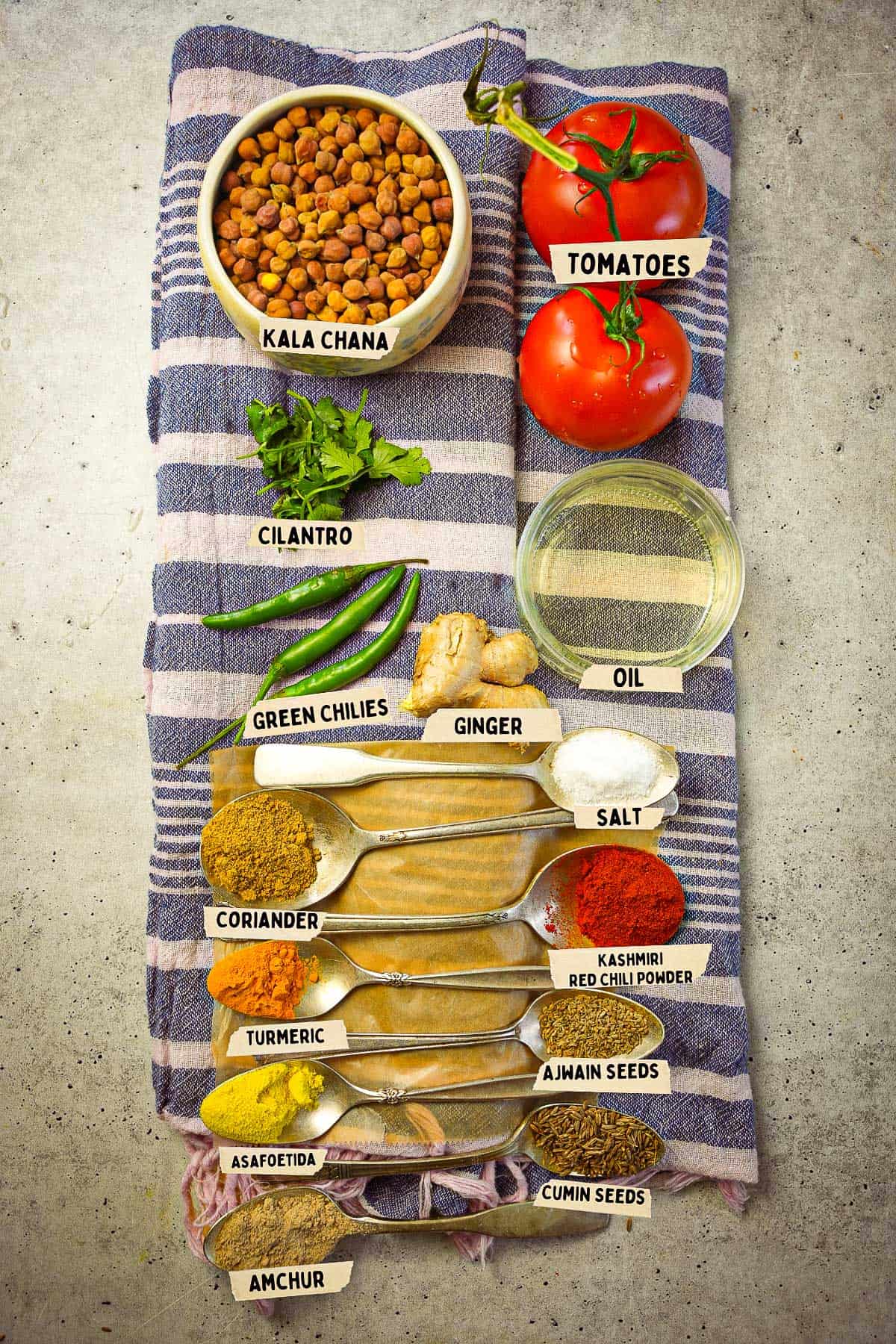

Get my fave cumin seeds for free!
Using this link, add the wild mountain cumin to your cart, spend at least $15 on some of the other absurdly good spices from Burlap & Barrel (they all seriously slap) and the bottle of this bangin' wild mountain cumin becomes FREE, and you will love it so much.

Kala Chana (Black Chickpeas)
These nutrient-rich legumes are an excellent source of plant-based protein, fiber, and essential minerals like iron and potassium. They are smaller, and of course darker, than regular chickpeas. In Sukha Kala Chana, their earthy flavor and firm texture add substance to the dish. If dry kala chana unavailable, you can substitute them with regular chickpeas or other beans of your choice.
Ajwain Seeds
Ajwain seeds have a pungent, slightly bitter taste with a hint of thyme-like aroma. They are familiar to most people from their frequent use in the dough or filling of samosas.
Amchur Powder
Derived from dried green mangoes, amchur powder adds a sour taste that enlivens the other flavors in this curry. Its acidity also acts as a natural tenderizer for the chickpeas, which is why I use it in my chana masala too. If you don't have amchur powder, you can substitute it with a squeeze of lemon juice or some tamarind concentrate for a similar taste and effect.
Asafetida
Commonly used in sattvic Indian cuisine in place of onions and garlic, asafetida powder has a strong and pungent aroma. If you don't have asafetida powder and don’t follow a sattvic lifestyle, you can substitute it with a small amount of finely minced garlic for a similar savory note.
Green Chilies
Indian hari mirch adds a some nice heat to the dish. Heck they make a great green chili pickle on their own! Adjust the quantity of green chilies according to your spice preference. You can substitute with seranno chilies or jalapeños if you can’t find ‘em.
*See the recipe card at the bottom of the page for exact quantities, nutritional info, and detailed cooking directions.
📖 How to make sukha kala chana
You wanna majorly upgrade your Ashtami Prasad? I will walk you through the whole process. Or you can follow along with the easy-to-print recipe card towards the bottom of this page.

Step 1
Rinse the dry kala chana (black chickpeas) thoroughly under running water to remove any dirt or impurities. In a large bowl, place the rinsed chickpeas and cover them with 6 cups of water. If you live in a hot climate, I recommend soaking the chana under refrigeration to prevent spoilage. Allow the chickpeas to soak for about 8 hours or overnight to soften and hydrate.
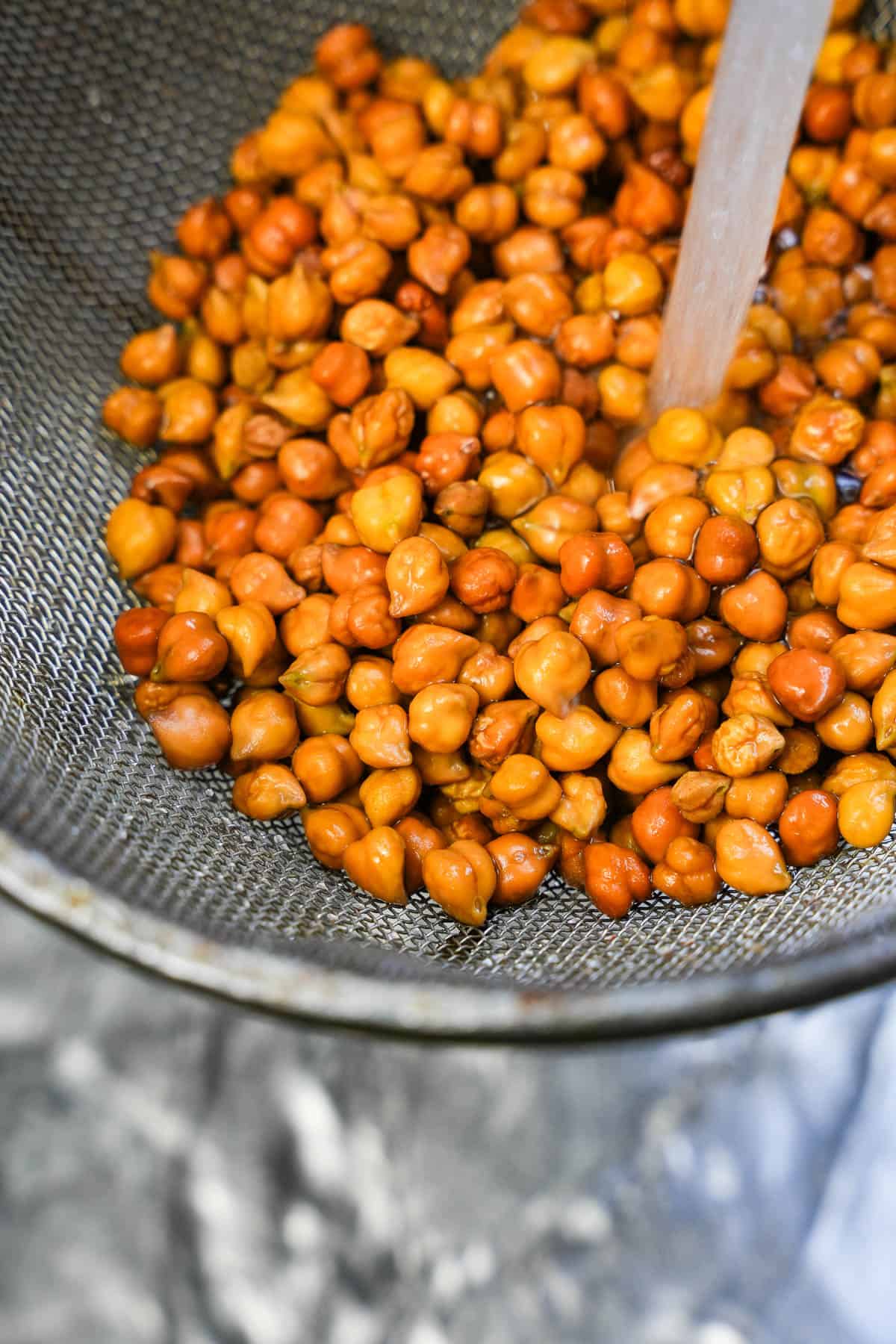
Step 2
After the soaking period, drain the water from the chickpeas and give them another quick rinse. Set aside.
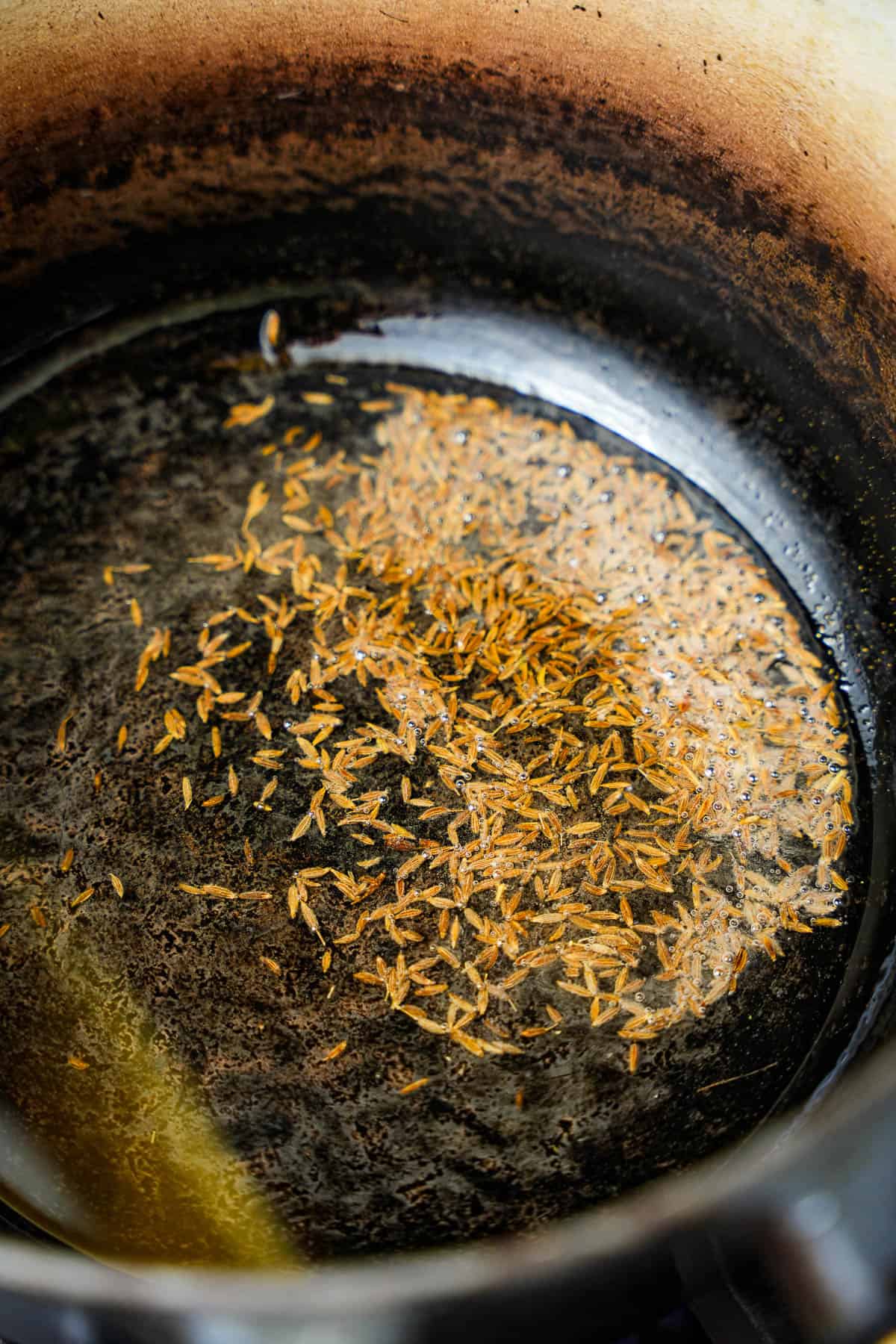
Step 3
Heat a pressure cooker or a large pot over medium heat. Add the oil of your choice and allow it to heat for about 60 seconds until it becomes hot.
Once the oil is sufficiently heated, add the cumin seeds to the pot and let them sizzle for a few seconds until they become aromatic, releasing their flavors.

Step 4
Now, add the grated fresh ginger, amchur powder (dried mango powder), ajwain seeds, asafetida, minced green chilies, turmeric powder, Kashmiri red chili powder, and coriander powder to the pot. Stir well to combine all the spices and let them cook together for about a minute.

Step 5
Stir in the diced tomatoes and salt. Continue cooking for 3-4 minutes until the tomatoes soften, and their skins start to wilt.

Step 6
Add the soaked and drained kala chana (black chickpeas) to the pot along with two cups of water. Stir everything together to ensure the chickpeas are well coated with the flavorful spice mixture.
👉If using a pressure cooker: Close the lid of the pressure cooker and cook over medium-high heat until you hear the whistle sound. Once the whistle is heard, reduce the heat to low and let the chickpeas cook for another 15-20 minutes. After cooking, remove the pressure cooker from heat and allow the pressure to release naturally before opening the lid.
👉If using an instant pot: Close the lid of the instant pot, set the valve to the sealing position, and select the pressure cook/manual mode. Adjust the time to 20 minutes on high pressure. Once the cooking time is complete, let the pressure release naturally.
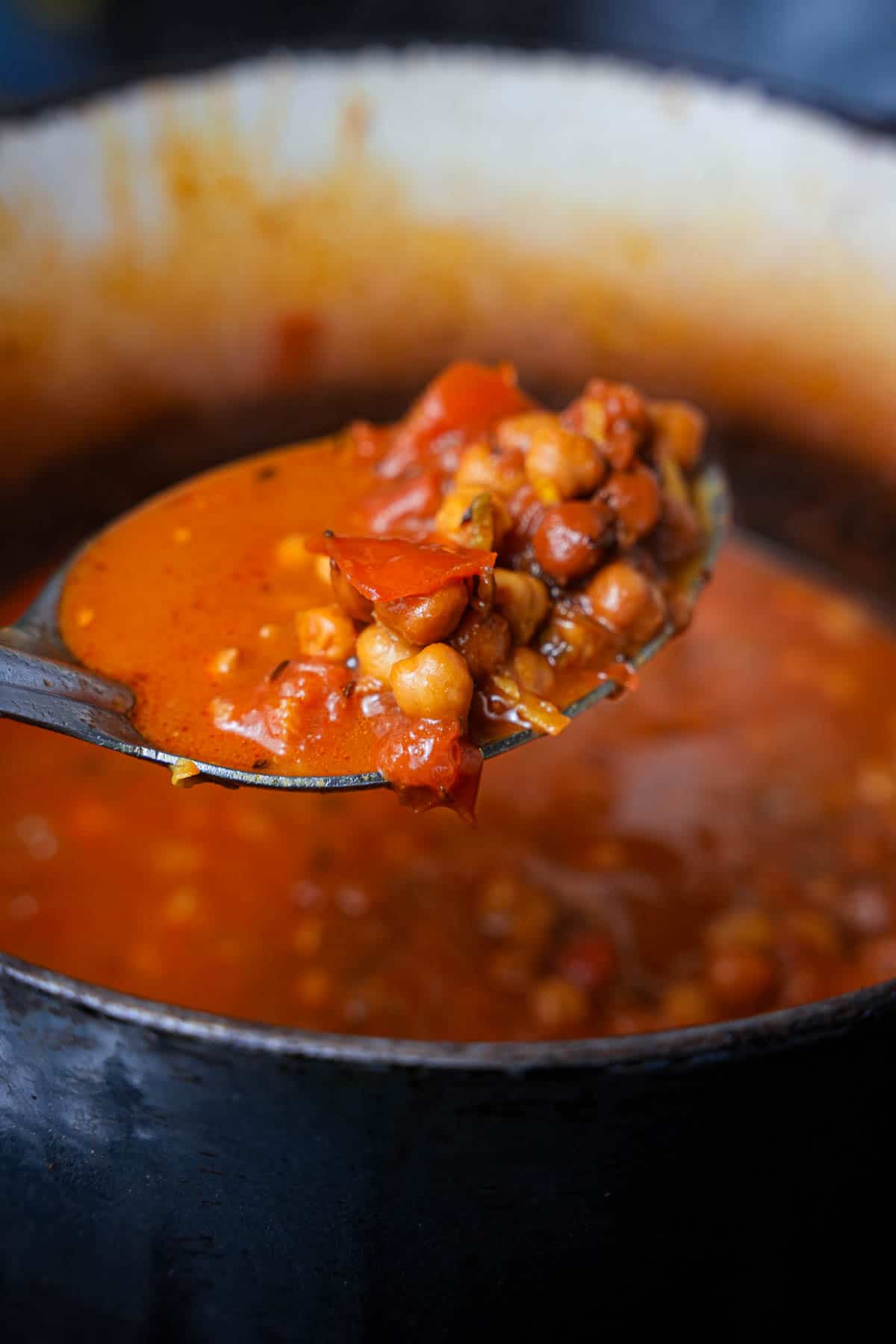
Step 7
After cooking, carefully open the lid and check the tenderness of the kala chana. They should be soft and thoroughly cooked. If needed, simmer the curry for a few more minutes until the desired consistency is reached. If the mixture appears too dry, you can add some water to adjust the consistency.
➡️ Kala chana will not get as soft as ordinary chickpeas, but if they don't feel tender yet, continue to cook until they are ready.
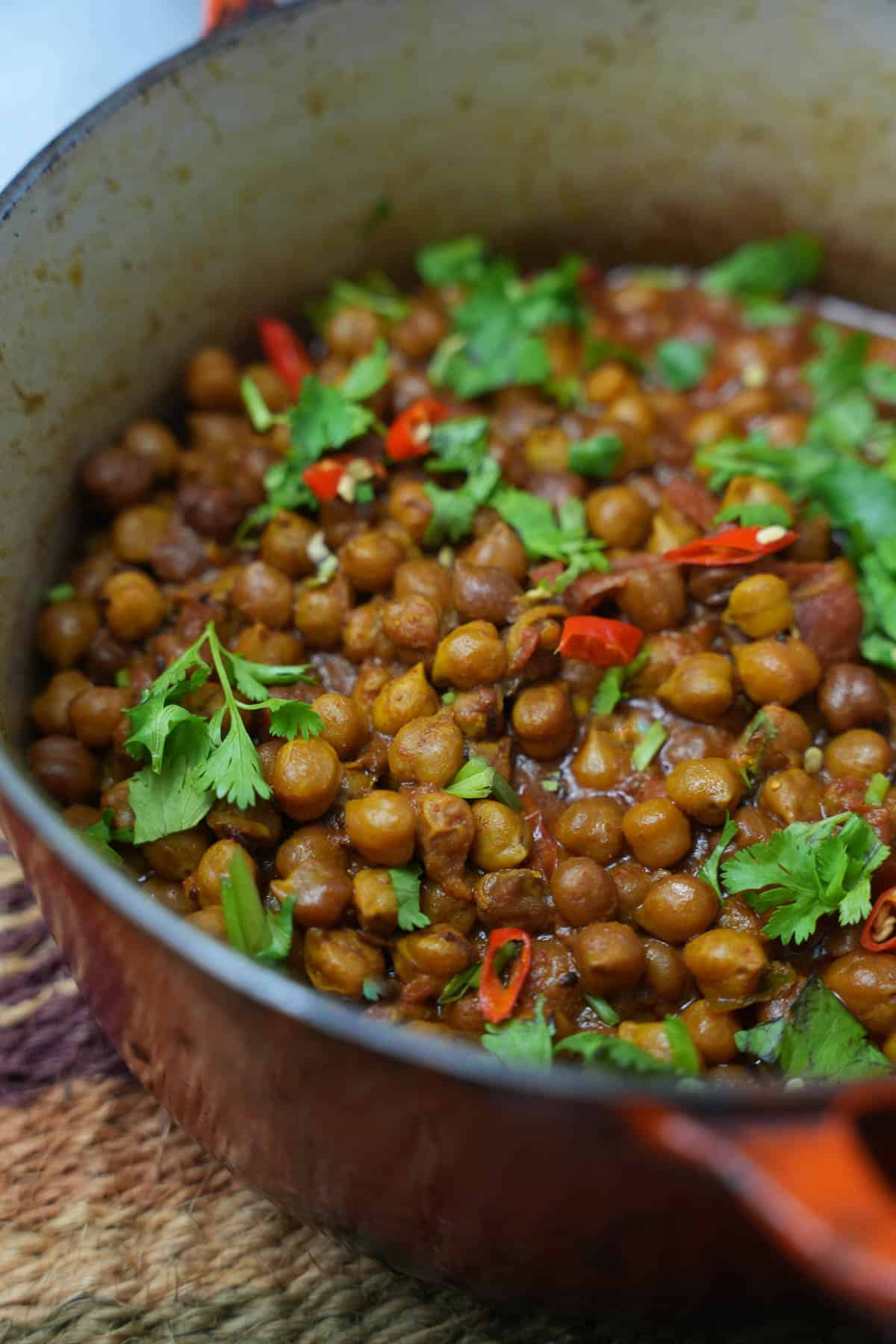
Step 8
Garnish the Sukha Kala Chana with finely chopped cilantro or coriander leaves.
🍽️Serving Ideas
Sukha Kala Chana pairs well with a range of sattvic dishes, complementing their flavors and adding protein to your meal.
Serve it alongside Aviyal and Olan, two mild South Indian curries packed with nourishing veggies. Or try it with Saag Aloo, or Punjabi Bhindi, two nourishing North Indian veggie dishes. Parwal- a curry made from small pointed gourds, peerkangai curry, or Lauki ki Sabji, made with bottle gourd, are great low-carb choices to pair this with. Add really yummy sweet potatoes to your life with Shakarkandi ki Chaat, topped with crispy sev and pomegranate seeds. Phool Makhana Sabji, or masala makhana are two great lotus seed dishes you could serve with kala chana, and both are sattvic with awesome textures.
Serve Sukha Kala Chana over fragrant Coconut Rice with Kerala parotta, or potato stuffed Amritsar kulcha to scoop it all up with!
Add condiments like Pickled Mango, Spicy Cucumbers, or Gajar ka Achar to elevate the flavors and complete your meal.

👉Top tips
No one likes undercooked, tough kala chana curry. Make sure it’s perfectly cooked:
- Make sure the Kala Chana is fresh: When purchasing the kala chana, make sure the bag looks new and well sealed. Don’t purchase the kala chana if there is a lot of dust or debris, or the chana looks degraded. If it’s terribly old, it will not cook nicely, no matter how patient you are.
- Soaking and Cooking Time: Soaking the kala chana for an adequate amount of time is crucial for achieving tenderness. As mentioned in the recipe, soak the chickpeas for about 8 hours or overnight. Longer soaking can further soften them. Additionally, cook the chickpeas for a sufficient duration. For instant pot kala chana or if using a pressure cooker, follow the recommended cooking time, usually around 15-20 minutes after the first whistle. For stovetop cooking, simmer the chickpeas for approximately 25-30 minutes until they become tender when pressed between your fingers.
- Test for Doneness: To check if the kala chana is tender enough, take a cooked chickpea and gently press it between your fingers. It should yield easily and feel soft. If they are still firm or have a hard center, they need more cooking time. Continue simmering or pressure cooking until the desired tenderness is achieved.
🤷♀️FAQ
Sukha Kala Chana is a dry, spiced black chickpea curry often served during Ashtami celebrations as Prasad. It is a sattvic dish, prepared without onion and garlic, and features a balanced mix of aromatic spices, cilantro, diced tomatoes, and tender black chickpeas.
On the other hand, Punjabi Kala Chana refers to a curry made with black chickpeas that has a thicker and more gravy-like consistency. This Punjabi version typically includes onions, tomatoes, ginger, garlic, and a blend of Punjabi spices like garam masala, cumin, and coriander. It is a popular North Indian dish often enjoyed with rice or Indian flatbreads.
What makes this kala chana suitable as Ashtami Prasad?
Ashtami Prasad should adhere to the principles of sattvic food. Sattvic food is pure, fresh, and excludes onion and garlic, which are believed to increase Rajasic and Tamasic qualities. While preparing Ashtami Prasad, infuse it with positive energy, love, and devotion. Offer your prayers and seek blessings from the deity for the prasadam to be accepted and considered sanctified.
Navaratri is a vibrant Hindu festival that spans nine nights and celebrates the divine feminine energy. It symbolizes the triumph of good over evil and is observed with great devotion and joy across India. During Navaratri, devotees engage in fasting, prayer, and various cultural activities.
Ashtami, the eighth day of Navaratri, holds immense significance as it represents the power and blessings of the goddess Durga. Kala Chana, or black chickpeas, is often used as an essential offering, known as Ashtami Prasad, during the Ashtami celebrations. What transforms the sattvic dish into prasadam is the devotional act of offering it as bhoga, making it sanctified.
It is believed that consuming Kala Chana as prasadam on Ashtami bestows boons of material and spiritual well-being, and strengthens the devotee's connection with the divine feminine energy.
Durga is the illusory energy (Maya) of Sri Krsna, the supreme personality of Godhead. She manifests as the material energy (Prakriti), which our physical reality is composed of.
In the Srimad Bhagavata Purana, Durga incarnates through several different personalities. My favorite story from the Bhagavatam about Durga is her incarnation as the daughter of Prajapati Dakṣa named Sati. Sati is married to Lord Siva, who Dakṣa doesn’t like. Dakṣa takes Siva’s austere appearance and company of low-natured beings to be inauspicious.
During an assembly, in a meditative trance, lord Siva doesn’t stand up to offer Dakṣa respect, and his wife’s father takes that as offensive. Dakṣa’s slandering Lord Siva brings shame to Sati, who sacrifices her own body in an act of self-immolation, because she can’t bear to have taken birth from someone who would slander Lord Siva. Her actions at the yajña arena of her father demonstrate the material detachment a yogi or devotee should feel when faced with aparadh (offense) to the Lord.
You can read the whole account in the 4th canto of Srimad Bhagavatam, chapters 2-5.
✌️See ya later, ‘frigerator
Store leftover Sukha Kala Chana in an airtight container in the refrigerator for up to four days.
To reheat, follow these instructions:
🔥Stovetop reheating
Heat a non-stick pan or saucepan over low to medium heat.
Add the desired amount of Sukha Kala Chana, stirring occasionally.
If needed, add a splash of water to prevent sticking and maintain moisture.
Cover the pan and simmer for 5-6 minutes until heated through.
☢️Microwave Reheating
Transfer Sukha Kala Chana to a microwave-safe dish.
Cover and microwave on medium power (50%) for 2 minutes.
Stir and check the temperature.
Continue microwaving in short intervals until heated to your liking.
Sure! Portion the fully cooked dish into small portions in airtight containers, and label them. Freeze for up to three months. Thaw overnight in the refrigerator.
✌️My faves to serve with this Navratri kala chana recipe:
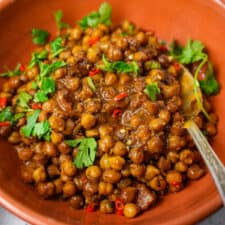
Sukha kala chana (Navratri black chickpea curry)
Equipment
Ingredients
- 1 cup dry kala chana black chickpeas or desi chana
- 6 cups water
- 3 tablespoons canola oil vegetable oil, or sunflower oil
- 1 teaspoon cumin seeds
- 1 ½ teaspoons grated fresh ginger
- 1 teaspoon amchur powder dried mango powder
- ½ teaspoon ajwain seeds carom seeds
- ½ teaspoon asafetida hing
- 3 green chilies hari mirch minced
- ½ teaspoon turmeric powder
- 1 teaspoon Kashmiri red chili powder
- ¾ teaspoon coriander powder
- 1 ¼ cups diced tomatoes
- 1 ¼ teaspoon salt
- 2 cups water
- ¼ cup cilantro leaves
Instructions
- Rinse the dry kala chana (black chickpeas) thoroughly under running water. In a large bowl, soak the kala chana in 6 cups of water for about 8 hours or overnight. If you live in a hot climate place the chana under refrigeration.
- After soaking, drain the water and rinse the chickpeas again. Set aside.
- Heat a pressure cooker or a large pot over medium heat. Add the oil and heat it for 60 seconds.
- Once the oil is hot, add the cumin seeds and let them sizzle for a few seconds, becoming aromatic.
- Stir in the grated fresh ginger, amchur powder, ajwain seeds, asafetida, minced green chilies, turmeric powder, Kashmiri red chili powder, and coriander powder. Mix well and let the spices cook for about a minute.
- Add the diced tomatoes and salt to the pot and cook for 3-4 minutes until the tomatoes soften, the skins wilting.
- Add the soaked and drained kala chana to the pot along with 2 cups of water. Stir everything together.
- If using an ordinary pot on the stove: put on the lid and cook on medium-low heat for 30-35 minutes. You will need to open the pot to stir occasionally. Use a heavy-bottomed pot to avoid burning, and add water if the pot runs dry.
- After cooking covered for 30 minutes, remove the lid and continue to cook uncovered for 15-20 minutes until most of the liquid has evaporated and the kala chana is tender.
- If using a stovetop pressure cooker: Close the lid and cook on medium-high heat until you hear one whistle. Then reduce the heat to low and let it cook kala chana for another 15-20 minutes. Remove from heat and let the pressure release naturally.
- If using an instant pot: Close the lid, set the valve to the sealing position, and select the pressure cook/manual mode. Cook on high pressure for 20 minutes. Once done, allow for a natural pressure release.
- After cooking, open the lid and check if the kala chana is tender and cooked through. If needed, simmer for a few more minutes until desired consistency is reached. Add water if the mixture has become too dry.
- Garnish with freshly chopped cilantro or coriander leaves.
Notes
- Soaking the kala chana for the recommended time (overnight) ensures they cook evenly and become tender.
- Check the tenderness of the chickpeas by gently pressing them between your fingers. They should be soft and easily mashed. If they are still slightly firm, continue simmering until desired tenderness is achieved.
- Adjust the quantity of green chilies according to your preferred level of spiciness.
- If the curry becomes too dry during cooking, add a little water to maintain the desired consistency.
- Taste and adjust the seasoning (salt and spices) according to your preference before serving.

Enter your email & I'll send it to your inbox. Plus, get great new recipes from me every week!
By submitting this form, you consent to receive emails from Cinnamon Snail.



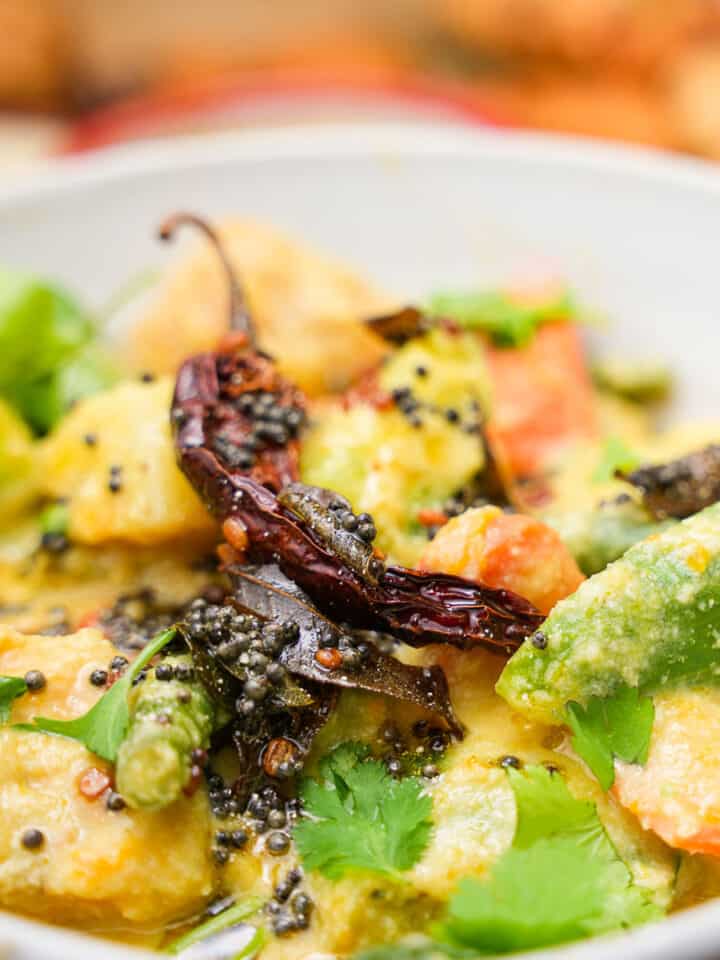
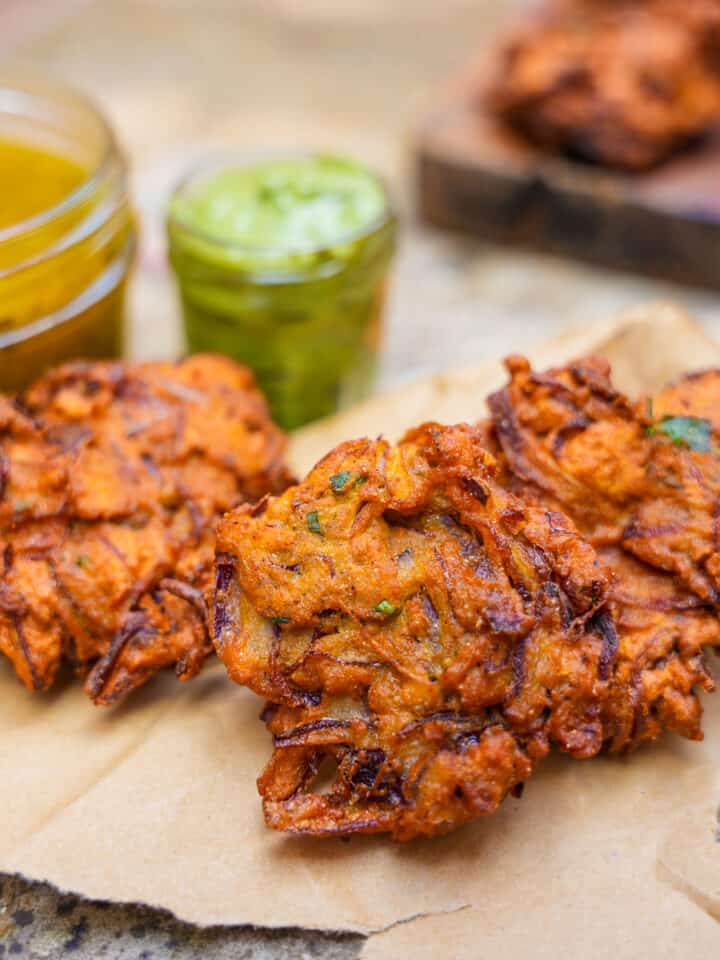




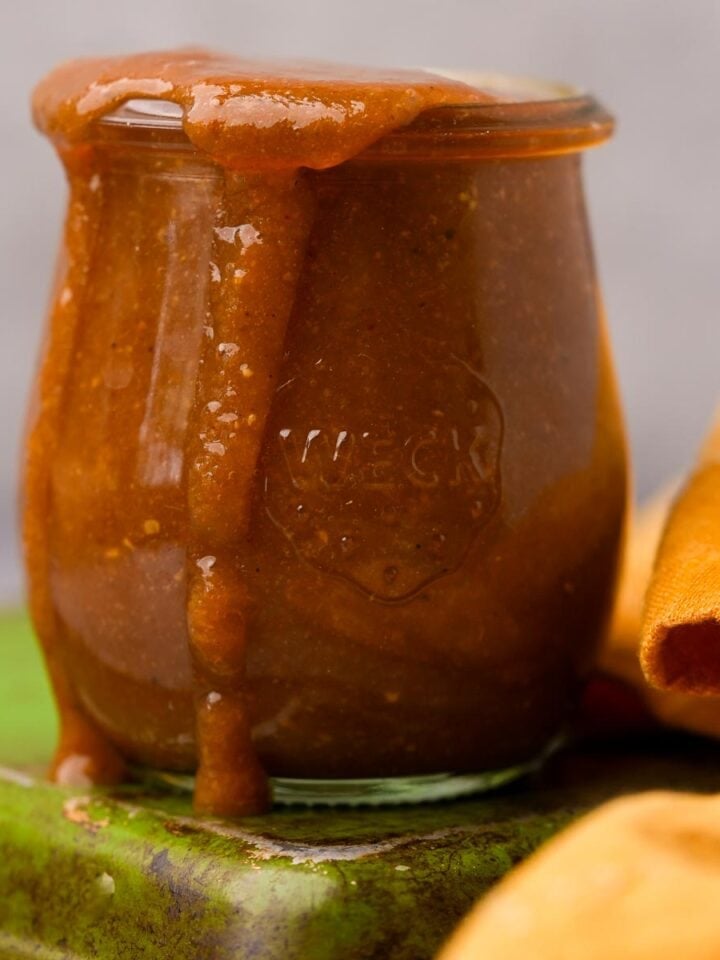

Meg says
This is soooo good. The balance of flavours—perfect. Thank you Chef Adam.
(I added some gram flour in water to thicken slightly—this was an instruction in the Chana masala recipe…another winner—and it made more of a luscious tasty gravy and toned down the heat slightly. )